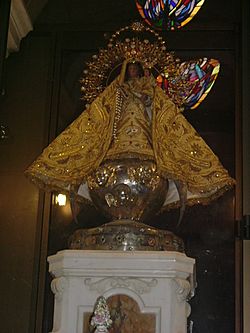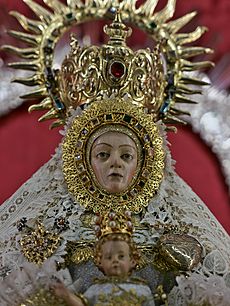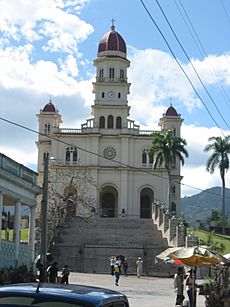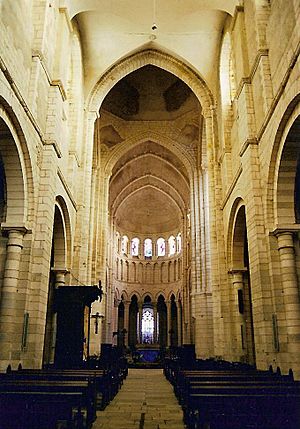Our Lady of Charity facts for kids
Our Lady of Charity (which means Our Lady of Love or Our Lady of Caring) is a special name for the Blessed Virgin Mary that many Catholic countries honor.
You can find similar statues and images of Our Lady of Charity in places like Cuba, France, Italy, Mexico, the Philippines, Spain, and the United States of America.
Contents
Our Lady of Charity of El Cobre, Cuba
Quick facts for kids Our Lady of Charity of El CobreQueen and Patroness of Cuban peoples |
|
|---|---|

The present image enshrined in the Minor Basilica of Nuestra Señora Caridad del Cobre
|
|
| Our Lady of Charity, Mother and Patroness of Cuba, La Cachita | |
| Venerated in | Roman Catholic Church |
| Major shrine | Basilica of El Cobre, Cuba |
| Feast | September 8, Feast of Nativity of the Blessed Virgin Mary |
| Attributes | The Blessed Virgin Mary carrying the Christ child and holding a crucifix atop an inverted crescent moon, with triple cherubs, encrusted with jewels and golden crown and aureole halo, embroidered gold mantle with the Cuban flag |
| Patronage | Cuba, Cuban peoples, salt and copper miners |
| Controversy | Cuban and slave independence, tolerance towards mixed Mulatto races |
The story of La Vírgen de la Caridad del Cobre (Our Lady of Charity of El Cobre) began around the year 1612. People believe the statue was brought to Cuba by Spanish settlers from a town in Spain called Illescas, where a similar statue of the Virgin Mary was already very popular.
The Story of the Three Juans
Local stories say that Spanish ship captains often carried religious images of Mary to protect them from pirates at sea. One day, two Native American brothers, Rodrigo and Juan de Hoyos, and an African slave child named Juan Moreno, went to the Bay of Nipe to collect salt. They are often called the "three Juans." They needed the salt to preserve meat for the workers in a nearby town.
While they were in the bay, a big storm suddenly started. Their small boat was tossed around by huge waves. The child, Juan, was wearing a medal with an image of the Virgin Mary. The three men began to pray to her for safety.
Suddenly, the sky cleared, and the storm was gone. In the distance, they saw something strange floating in the water. They rowed closer as the waves brought it towards them. At first, they thought it was a bird, but then they saw it was a small statue of a girl. They realized it was a statue of the Virgin Mary holding the child Jesus in her left arm and a gold cross in her right hand. The statue was attached to a wooden board that said, "Yo Soy la Vírgen de la Caridad" (meaning "I am the Virgin of Charity"). What was amazing was that the statue was completely dry, even though it had been floating in the water!
The Statue's Journey
Very excited, the three men quickly returned to their town. They showed the statue to a government official, who ordered a small chapel to be built for it.
One night, Rodrigo went to visit the statue, but it was gone! He organized a search party, but they couldn't find Our Lady of Charity. The next morning, she was back on the altar, as if nothing had happened. This was very strange because the chapel had been locked. This happened three times. The people realized that the statue wanted to be in a different place. So, they took her to El Cobre. Everyone in El Cobre was very happy, and the church bells rang when she arrived. This is how she became known as "Our Lady of Charity of El Cobre." But even in El Cobre, the statue kept disappearing.
One day, a young girl named Jabba was playing outside, chasing butterflies near the Sierra Maestra mountains. She found the statue on top of a small hill. Some people believed her, and some didn't. But in the end, the Virgin was taken to the spot where she was found, and a church was built there for her.
Freedom and Importance
Before the famous statue was officially recognized, King Charles IV of Spain declared in 1801 that Cuban slaves working in the El Cobre copper mines should be freed. This news spread quickly across the island. Many people felt that the Virgin Mary chose El Cobre for her home because it was a place where people were seeking freedom.
Later, people started taking small pieces of copper from the mines, having them blessed near the Virgin's statue. They believed this brought good luck and healing.
Official Recognition
Pope Pius XI officially honored the statue in 1936. Later, Pope Paul VI made her church a special "Minor Basilica" in 1977. The special day to celebrate Our Lady of Charity is September 8, which is also believed to be the birthday of the Virgin Mary.
Description of the Image
The statue in Cuba is about 16 inches tall. Her head is made of baked clay and covered with a smooth white layer. Her feet rest on a shining moon, and angels spread their golden wings on a silver cloud. The Child Jesus raises his right hand to give a blessing, and in his left hand, he holds a golden globe.
A popular image of Our Lady of Charity has a banner above her head that says in Latin, “Mater Caritatis Fluctibus Maris Ambulavit” (meaning: "Mother of Charity who walked on the road of stormy seas"). Originally, her clothes were white. Newer clothes are decorated with gold and silver, and they even include the national symbol of Cuba. Among Cubans who love her, the statue is lovingly called La Cachita.
The statue stands on a platform behind glass, above the altar in the El Cobre basilica. The color yellow is often linked to the Virgin of Charity, and her shrines are usually filled with yellow flowers.
There is also a chapel dedicated to Our Lady of Charity inside a large church in Washington, D.C., in the United States.
Popes and the Cuban Virgin
- In 1915, Cuban freedom fighters asked the Pope to make Our Lady of Charity the patroness of their country.
- Pope Benedict XV officially declared her the Patroness of Cuba in 1916, at the request of soldiers who fought for Cuba's independence.
- Pope Pius XI officially crowned the image in 1936.
- Pope Paul VI made her church a special "Minor Basilica" in 1977.
- Pope John Paul II crowned the image again during his visit in 1998.
- Pope Benedict XVI gave a special "Golden Rose" honor to the image and her church in 2012.
- Pope Francis placed a statue of Our Lady of Charity in the Gardens of Vatican City in 2014.
Cuban National Symbol
The Virgin of Charity is one of Cuba's most important figures. She represents hope and safety, especially when times are tough. Over time, La Cachita has become a key symbol of Cuban identity. She brings together Cubans both in their home country and those living abroad, no matter their background. Wherever Cubans have moved, they have brought their love for la Caridad with them.
For Cubans who follow Yoruban religious practices, Our Lady of Charity is also connected to the spirit Ochún.
Ernest Hemingway's Gift
In 1954, the famous American writer Ernest Hemingway gave his Nobel Prize in Literature medal to the statue of Our Lady of Charity at her church in Cuba. He won the prize for his book The Old Man and the Sea.
The medal was stolen in 1986 but was found a few days later after Raúl Castro demanded its return. After it was returned, it was hidden for a while. The medal is now very rarely seen on the statue and is only worn during very special events or when a Pope visits.
Our Lady of Charity in Other Countries
France
In La Charité-sur-Loire, France, there was a very large and famous monastery called the Abbaye de la Charité. When its church, Notre-Dame-de-La-Charité, was built in the 11th century, it was the second largest building in Europe. It has been a UNESCO World Heritage Site since 1998.
There was also a small chapel of Our Lady of Charity near "Sainte Laurent sur La Plaine." This chapel was destroyed in 1791 during the French Revolution. Soon after, people reported seeing Mary appear on the ruined altar and in a nearby oak tree. This led to more people visiting the site and was part of the events leading up to a conflict called the War in the Vendée. Today, a small statue is on the altar in the newly rebuilt church.
Italy
A special image of the Madonna and Child (Mary and Jesus) with this name is very popular in Moschiano, Italy.
Pope Leo XIII officially honored this image in 1886.
Mexico

Pope Paul VI officially crowned a statue of Our Lady of Charity in Huamantla, Mexico, in 1974. The Pope also made her church a "Minor Basilica" in 1978.
Spain

An older image of Our Lady of Charity, which came before the Cuban one and was its source, is honored in Illescas, Toledo, Spain. Stories say it was copied from an ancient image and brought to Toledo by Saint Paul the Apostle around 50-60 A.D. In the 16th century, it was moved to a hospital where a famous miracle happened: a paralyzed patient was healed in 1562.
Another honored image of Our Lady of Charity in Cartagena was officially crowned by Pope Pius XI in 1923.
Pope Paul VI also officially crowned an image in Sanlúcar de Barrameda, Andalusia, in 1965. Pope John Paul II later made her church a "Minor Basilica" in 1997.
Philippines

In the Philippines, Our Lady of Charity is known as Apo Caridad (meaning "Mistress of Charity") in the Ilocano language. This image is a copy of an older image from Toledo, Spain.
- Pope Pius XII officially crowned an image in 1955. It was crowned in 1956 and named the "Patroness of Ilocandia." This image is in the Bantay Church in Bantay, Ilocos Sur.
- Another image of Our Lady of Charity is in the Minor Basilica of Our Lady of Charity in Agoo, La Union. This image was crowned in 1971. Pope John Paul II made her church a "Minor Basilica" in 1982.
United States of America
In 1961, the Archdiocese of Miami celebrated the feast of Our Lady of Charity with 30,000 Cuban exiles. A 16-inch copy of the statue had been secretly brought out of Cuba. Because so many Cubans loved this image, the Archdiocese of Miami decided to build a special church for Our Lady of Charity in 1966.
The church, called La Ermita de la Caridad, was built on the shores of Biscayne Bay in Miami. It was finished in 1973, with money donated by Cuban exiles.
Churches Honoring Our Lady of Charity
Cuba
- El Cobre
France
- La Charité-sur-Loire (Priory)
Mexico
- Huamantla, Tlaxcala (Minor Basilica)
Spain
- Cartagena
- Villarrobledo
- Illescas
- Loja and The Garrovilla
- Camarena
The Philippines
- Quezon City, Metro Manila
- Agoo, La Union (Minor Basilica)
- Bantay, Ilocos Sur
United States of America
- Miami, Florida
- Cicero, Illinois
- Buffalo, New York
See also
 In Spanish: Virgen de la Caridad del Cobre para niños
In Spanish: Virgen de la Caridad del Cobre para niños




